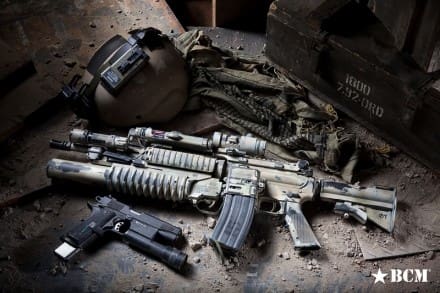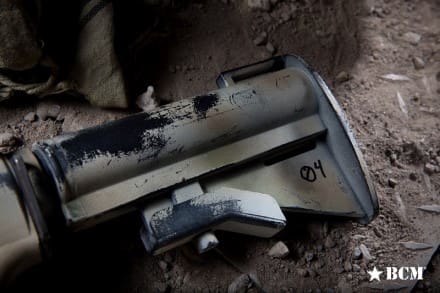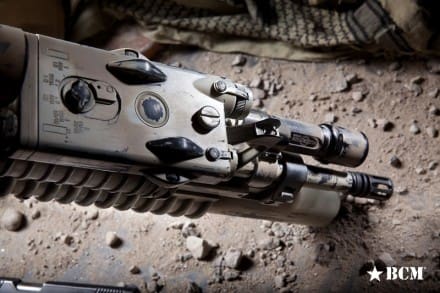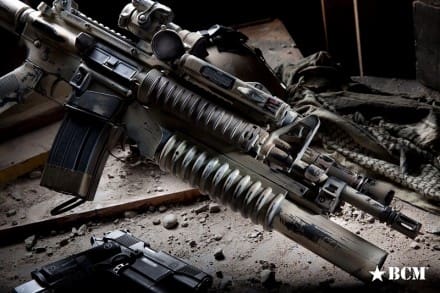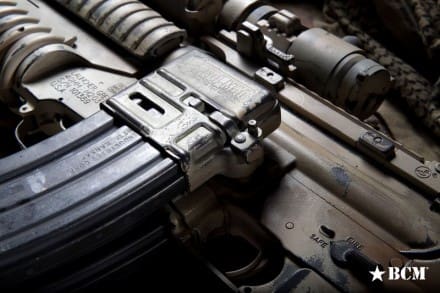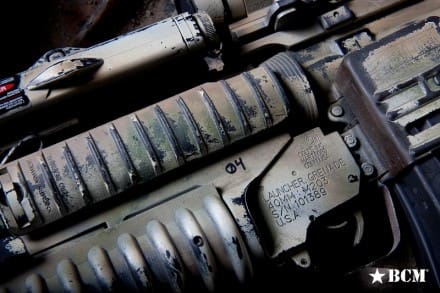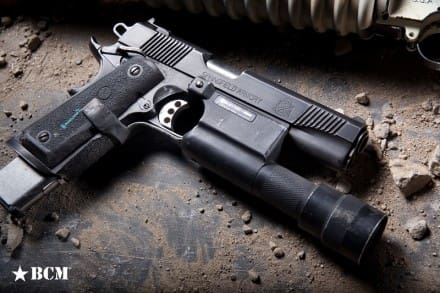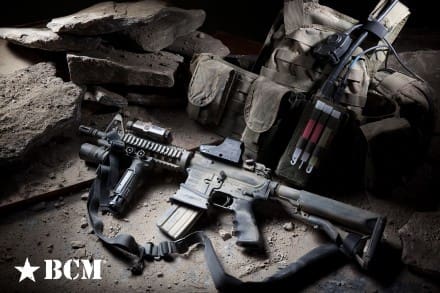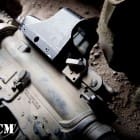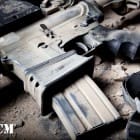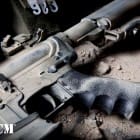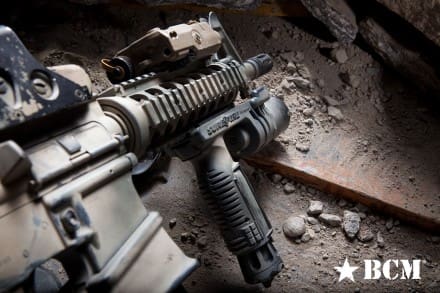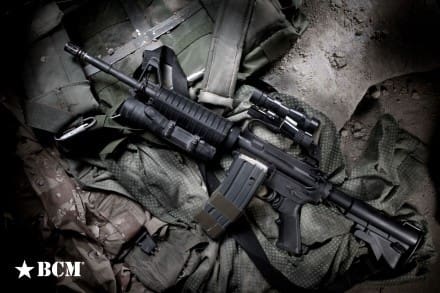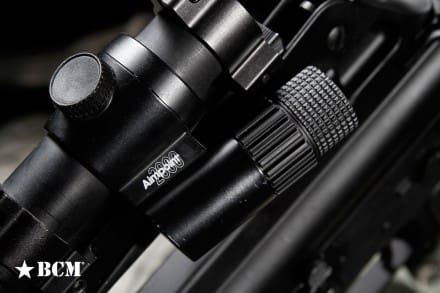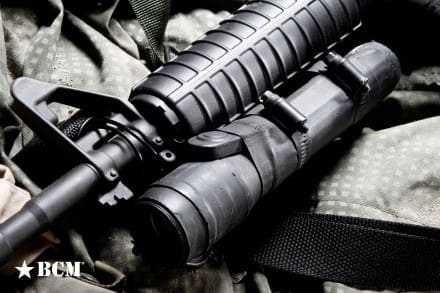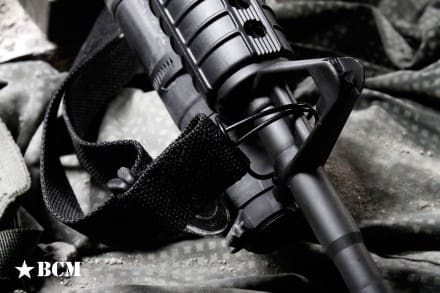Hanging in my office is a clone of the rifle I carried on two combat tours (Iraq and Liberia). It’s a reminder of where I came from, where I stand today, where I am going and why I am going there.
While serving in 2nd Force Reconnaissance in the late 1990’s and early 2000’s, my unit started seeing radical advances in small arms and light weaponry via the SOPMOD program. Suddenly, carbines could quickly be fine-tuned for specific missions by mounting night vision systems, laser aiming devices, weapon lights and red dot optics to the 1913 Picatinny Rail Systems on the upper receiver and handguard.
These technologies opened up whole new tactics, techniques and procedures that could be employed to prosecute our mission of specialized reconnaissance, ambush and direct action raids.
Despite the additional capabilities the SOPMOD program delivered, opinions were sharply divided on the program. Some saw these tools as a burden, adding a lot of “crap” that would only increase the amount of weight our Marines carried on mission for little tangible benefit. A maxed out M4 could run up to 14 pounds, but we didn’t need every component for every mission.
Two Pounds of Metal
The SOPMOD accessory package that my platoon ended up running included almost two pounds of weight in mounting interfaces alone. When I challenged this, I got a typical Marine Corps answer, “Because that’s what you are issued, now quit asking irrelevant questions, Too Speed.” (Too Speed was my call sign.)
I couldn’t accept that answer. It was an institutional answer that repeated a party line and the lives of my teammates were, and will always be, more important than not rocking the boat.
After some trial and error, the first mod I made was to ditch the Surefire M951 Weapon Light and replace it with a Surefire 6P in a shotgun tube light mount that I scored at a sporting goods shop near base. After swapping the 6P tail cap for the M951 remote switch assembly, I then ran the tape switch on the left side of the 203 so activating the light wouldn’t impact my weapons manipulation.
Getting a weapon light in tight with a rail and shaving weight off the interface was something I would spend the next 10 years fiddling with before I had a eureka moment and Haley Strategic Partners released the Thorntail Adaptive Series of light mounts, currently in use by military, security contractors and law enforcement worldwide.
This was a defining moment for me, as it was when I first started tweaking and eventually building original components for my platoon based on the unique requirements of our missions. These experiences of shaving weight, improving ergonomics and finding a balance between capability and utility, would drive the development of so many of the components I have commercialized in my post-service career.
The Rifle I took to War
Colt M4 with 14.5” Barrel
Colt M203 40 mm Grenade Launcher
Knights Armament RAS Handguard
PEQ-2 IR Aiming Laser
Surefire Classic 6P with a custom “Simply Dynamic” mount
Boone & Packer Redi-Mag
Simply Dynamic Multi-Mission Sling (commercialized by Magpul as the MS3)
Load Out
Prior to the invasion of Iraq, Force was trained up for both Green Side (reconnaissance) and Black Side (direct action) missions, with the assumption we would be tasked to one or the other. However, when we entered Iraq, our platoon found ourselves doing a combination of both at the same time. Force Recon is a special operations unit that prepares the battlespace and gathers intelligence for the MAGTF (Marine Air Ground Task Force) and then prosecutes specialized targets as directed.
With a few days under our belts, the entire platoon started striping gear and mags, looking for that perfect balance of speed, utility and capability. If you can’t move, you can’t be effective. Most of the Marines went from 13 rifle magazines to between five or six. I ended up with four on my vest and two taped together on my carbine with riggers tape and offset with a stick.
Force Recon ran low signature load outs, often working out of vehicles (mil and civilian), and running a double mag on the carbine meant I had 60 rounds at the ready. When I saw the “Redi-Mag” in a copy of Shotgun News, I ordered it and had it delivered to me overseas. Despite the weight, the Redi-Mag was more versatile than the old riggers tape and stick, and cut my carbine reloads to sub-one second.
I no longer run a Redi-Mag, because there are so many excellent belt mounted magazine pouches available today that I can reload at almost the exact speed as from a Redi-Mag. That said, you will sometimes find them on my house and car guns, as I do not expect to be kitting up if someone breaks into my house or I find myself engaged with an active shooter around vehicles in the streets.
M203
The M203 is a vital component to small and agile units, like Force, who operate in small units in semi-and-non-permissive settings. It becomes even more essential in worst-case scenarios where the mission is compromised or the unit is outright ambushed by an enemy force.
We prepared for scenarios where 203s could be employed for a hasty breach, in instances where a short count/stack was not possible, as well as a posturing tool to achieve immediate fire superiority in the face of an ambush. Finally, we practiced employing them to suppress fortified enemy positions in buildings by putting accurate fire through windows or open doors.
In fact, in the first gunfight I was involved in during OIF, I put this into practice, pumping 40mm HEDP(High Explosive Dual Purpose) rounds through windows of enemy positions 50 meters out. This fire created instant hate and discontent on target, where crew served weapons and M4s did not offer as much of an immediate positive effect. We had never trained to fire the M203 at such a close distance for safety reasons, but I held at the top of the window frame with my Aimpoint and the round went straight where I wanted it.
MEUSOC 1911
The MEUSOC 1911 has an almost legendary reputation among 1911 and handgun enthusiasts. One of the most high performance handguns ever built, the MEUSOC 1911 we ran was hand built by Marine Armorers from the Precision Weapons Section at MCBQ (Marine Corps Base Quantico). They fine tuned our 1911’s, hand selecting barrels, link pins, sear springs, ejectors, firing pin stops, mainspring housings and mainsprings. Slides were custom built by Springfield Armory with beavertail safeties and recoil spring guides by Ed Brown, Novak rear sights, Wilson Combat extractors + mag release buttons, and King’s Gun Works ambi thumb safeties.
Force ran the 1911 specifically in direct action raid or ambush missions. It was not a primary and would only come into play if our carbines had run dry or malfunctioned. We carried 10 round magazines with 230 Grain 45 ACP. More than enough to deal with any immediate situation and then refocus on the carbine to get it back into action.
On DRP (Deep Reconnaissance Patrol) Missions, I personally chose my Beretta M92, which was our only 9mm alternative at the time. The flatter trajectory at range of the 9mm and the larger magazine meant more bullets to deal with more problems in the event my carbine was down or permanently disabled.
When I later worked as a security contractor on Ambassador Bremmer’s detail with Blackwater, we would run Glock 17s. But in the end, the mission drives the gear – more importantly, the mission drives the man.
The Mission Drives the Man
When I first started making gear, I was doing it to help keep my guys alive. When I started my first company, Simply Dynamic Tactical, I wasn’t in it to get rich. I was doing it to pass on what I learned in combat and to provide tools that would stack the deck in the favor of the men and women who were going overseas or out on our streets as warfighters, law enforcement or private citizens.
Surviving war is an awesome responsibility. For those who have been in combat, you never forget the brothers you lost. When you are one of those who made it back, you carry a weight that is difficult to put into words. I was lucky to have known such great men in my life. I was lucky to have a second family closer than any people I will ever know.
As I approach the 5th year in business with Haley Strategic Partners, we have tried to bring this industry together and to stay focused on that one mission. Enable brave men and women to complete their missions as safely as possible. Through training, through gear and through mindset.
Stay Sharp and be safe.
Travis Haley
October, 2015
Presented by Bravo Company USA


